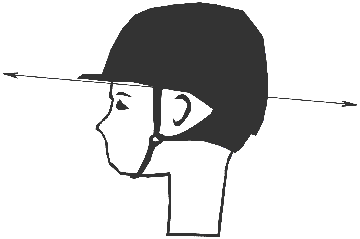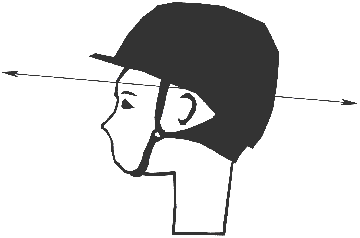| |
Home
Farmer/Rancher Safety
Young Farm Worker Safety
Children's Safety
Media
|
Design | Brain buckets | Structure | Why replace the helmet? | Fit | Care and storage | On standards testing... | ...And certification | The last word | References
Have you ever been asked that million-dollar question: What is your head worth? For those who enjoy riding horses and the freedom it gives, the answer to that question should be: My head is priceless.
Statistics have shown for years that the single most effective way to reduce the risk of potential head trauma while riding a horse is to wear an approved helmet designed for equestrian activities. Know the hazard. Know the job. Know the drill.
Design
Equestrian helmets are designed to protect a rider’s head in two ways. First they reduce penetration by sharp objects (the protective shell), and second absorb some of the force, giving the head a “cushion” thus increasing stopping distance (the foam padding). All models of ASTM/SEI approved equestrian helmets are tested in a lab to ensure that they are up to regulated safety standards. You can find the SEI certification symbol on each approved helmet.
Helmets intended for equestrian activities come in many sizes and although generally use the same protective foam, are built differently than other sporting helmets. They cover more area of a rider’s head and are designed for specifications of riding a horse, taking into account possible terrain, speeds, and objects to which a rider could be subjected. They are built to skid rather than stick over rough terrain and to absorb impacts created by sharp objects such as a horse hoof or sharp rock. They are also designed to be secured properly to a rider’s head and be light enough to not interfere with a rider’s balance.
Other sporting helmets such as a bicycle helmet or motorcycle helmet either don’t provide adequate head coverage, or they are too heavy and bulky to be used for riding.
|
Back to top
Brain Buckets...
If you ride horses, your helmet really is your best friend. Read on.
- Horseback riding carries a higher injury rate per hour of exposure than downhill ski racing, football, hang gliding and motorcycle racing.
- Medical examiner reports show that 60% or more of horse-related deaths are caused by head injuries.
- Helmets can reduce this possibility by 70-80%.
- Repeated trauma to the head, even when minimal, can cause cumulative damage to the brain. Each new incident expands the original damage and the brain cannot recover 100% from injury.
- Helmets that are not safety certified offer no protection whatsoever and are strictly for cosmetic purposes.
- Head injuries are the most common reason for horse related hospital visits.
|
Back to top
Structure
Because a riding helmet will absorb the force of a blow or fall, the foam padding is destructible. Once a helmet has absorbed an impact, the foam padding condenses and never regains its original shape. It will no longer provide adequate protection. A destructible impact could be a fall from a horse or simply being dropped on to a hard surface. For this reason once a helmet has been through a fall or direct impact of any sort, it must be replaced. It also needs to be replaced at least every five years as the foam deteriorates over time and becomes less effective. All ASTM/SEI helmets contain a manufacturer’s date with the SEI seal.
Some manufacturers offer replacement helmets at a reduced price for those that have been impacted. This information should be contained in the box with the helmet in a “User’s Manual” or on a tag attached to the helmet. To take advantage of this policy usually requires the original receipt.
Back to top
Why Replace the Helmet?
Glues, resins and other materials used to make the helmet eventually break down, affecting the interior liner. As well, regardless of use over time the protective foam becomes brittle. The inside liner will also start to deteriorate when it comes in contact with hair oils, body fluids and/or cosmetics over time. All this, in addition to normal wear and tear, leads to helmet degradation. Always check the manufacturer’s date located with the SEI certification seal. |
Back to top
Fit
Fit has a direct impact on the effectiveness of a helmet. A comfortable helmet is also more likely to be used regularly. It is a good idea for a rider to try on many helmets before settling on one, as each model fits a little differently. Some basic guidelines for fitting a helmet are:
- The helmet should fit around the entire skull and sit just above the eyebrows.
- It should feel snug, but not uncomfortably tight. If the helmet is gently wiggled, the skin around the forehead should move with it.
- All straps must be comfortably fastened with little play. Normal conversation should not be affected, but if the mouth is opened as if yawning, this should pull down on the helmet.
- If the helmet needs additional padding for a more secure fit, go with a smaller size or another model.
- Remember that the fit of a helmet will relax a little with use, so a snug fit is essential.
A properly fitted, well adjusted, and correctly positioned helmet is more likely to remain in place during an accident, will give the most protection available for the design, and will be the most comfortable to wear.
 | This helmet is sitting correctly, just above the rider's eyebrows and covering the back of the head. |
 | This helmet appears a bit too small and isn’t sitting low enough on the forehead. This could enable the helmet to shift in a fall. |
Back to top
Care and Storage
Extreme heat temperatures, UV rays, chemicals and solvents will damage the foam in a helmet. For these reasons a riding helmet should not be stored where temperatures can exceed 40 degrees Celsius, left out in the sun or stored near any chemicals. This would include a vehicle on a hot day, in a cabinet or tack box with bug repellent or bleach in it, or in a tack room with sunshine peaking through the window onto the helmet.
To clean a helmet use a mild detergent on the exterior for hard shell helmets, or use a brush on velvet. Helmet deodorizers and cleaners are available on the market and are recommended for the inner lining. Never leave a helmet in direct sunlight or near a heat source to dry.
Back to top
On Standards Testing...
ASTM (originally known as the American Society for Testing and Materials) is one of the world’s most respected
standards organizations. Volunteers from many fields review current versions of headgear standards and propose changes to the standards. The ASTM standard is widely used internationally as a basis for the standards developed in other countries. |
Back to top
...And Certification
SEI is Safety Equipment Institute, which certifies protective equipment in a number of areas, including head protective products. Any product bearing the SEI mark is manufactured to stringent requirements. In the case of equestrian helmets, every helmet bearing the SEI mark must be able to satisfy the impact and retention requirements of the ASTM standard, which is proven to reduce the risk of head injuries in equestrian activities. |
Back to top
The Last Word
While enjoyable, horseback riding is an inherently dangerous sport. Riders can minimize the hazards significantly with proper training and by wearing the proper gear. Studies prove that helmets can reduce risk and severity of brain injury so long as they are used consistently and properly. Wearing a helmet just gives a rider that added piece of mind.
Back to top
References
Wikipedia, the free encyclopedia, http://en.wikipedia.org/wiki/ASTM_International
The University of Vermont, American Equestrian Medical Association News, Why not use a bicycle helmet for horseback riding? http://asci.uvm.edu/equine/law/amea/feb96nws.htm#bike
How Products are Made, Expanded Polystyrene Foam (EPF), http://www.madehow.com/Volume-1/Expanded-Polystyrene-Foam-EPF.html
Total Bike, http://www.totalbike.com/news/article/608/
Beginner Triathelete.com, Helmet Lifespan, http://beginnertriathlete.com/discussion/forums/thread-view.asp?tid=129542
Back to top
Alberta Farm Safety Program
Email: farm.safety@gov.ab.ca
or toll-free: 310-FARM (3276)
Alberta Agriculture and Forestry Farm Safety Staff:
Janice Donkers, Youth Coordinator: janice.donkers@gov.ab.ca
Kenda Lubeck, Coordinator: kenda.lubeck@gov.ab.ca
Raelyn Peterson, Coordinator: raelyn.d.peterson@gov.ab.ca
Sharon Stollery, Manager: sharon.stollery@gov.ab.ca
Blair Takahashi, Specialist: blair.takahashi@gov.ab.ca |
|